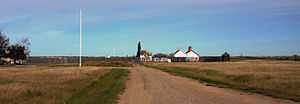Fort Battleford
| Fort Battleford | |
|---|---|
| At the confluence of the North Saskatchewan and the Battle rivers in Battleford, Saskatchewan, Canada | |
|
Fort Battleford National Historic Site | |
| Type | Fort |
| Site information | |
| Controlled by | Canada |
| Site history | |
| Built | 1876 |
| In use | 1876-1924 |
| Materials | wood |
| Battles/wars | |
| Official name | Fort Battleford National Historic Site of Canada |
| Designated | 1923 |
| Garrison information | |
| Garrison | North-West Mounted Police |
Fort Battleford was the sixth North-West Mounted Police fort to be established in the Northwest Territories of Canada, and played a central role in the events of the North-West Rebellion / Resistance of 1885. It was there when Chief Poundmaker was arrested, and when six Cree and two Stoney men were hanged for their participation in the Frog Lake Massacre and other killings.
Its location is near the confluence of the North Saskatchewan and the Battle rivers. This site offered access to fresh water, as it was many years before an on-site well was made available; it also offered an alternative means of transportation to the Red River Cart. As the site was also on a plateau, the fort was easily defensible, and offered clear lines of sight for the surrounding area and to Government Ridge – thus providing warning against possible attacks. The fort sheltered around 500 people, and they helped to fortify Battleford.
The fact that Battleford was then the newly designated capital of the Northwest Territories also played a substantial role in the decision to locate the fort there. The government's belief was that the presence of the NWMP would act as a civilizing influence on the First Nations in this area, and help them to transition from their nomadic lifestyle to a more stationary one, modelled on European societies. They also hoped that the force would assist settlers in their homesteading efforts, and that their presence in the area would encourage the people of the area to respect the laws and rules of the government.
The difficulties that had plagued Native American–government relations in the United States, along with the high Aboriginal population in the Battleford area, further prompted the federal government to establish a strong NWMP presence. Both the Canadian government and the First Nations were quite aware of what had transpired south of the "Medicine Line" and sought to follow a different path.
The original Canadian Pacific Railway route was also to pass through Battleford, along the Qu'Appelle route, but this was overruled in favour of a more southerly route – which resulted, later, in the moving of the capital of the North-West Territories from Battleford to Regina, then known as Pile o' Bones (and also the reason why Regina is the only provincial capital not built on a major waterway).
Legacy
In the spring of 2008, Tourism, Parks, Culture and Sport Minister Christine Tell proclaimed in Duck lake, that "the 125th commemoration, in 2010, of the 1885 Northwest Resistance is an excellent opportunity to tell the story of the prairie Métis and First Nations peoples' struggle with Government forces and how it has shaped Canada today."[1]
Fort Otter was constructed at Battleford's government house located at the capital of the North-West Territories (1876 and 1883). The largest Canadian mass hanging occurred here when eight First Nations men were executed in the aftermath of the Frog Lake Massacre.
The fort was designated a National Historic Site of Canada in 1923, known as Fort Battleford National Historic Site, to commemorate its role as military base of operations for Cut Knife Hill, Fort Pitt, as a refuge for 500 area settlers and its role in the Siege of Battleford.[2][3][4][5][6]
References
- ↑ "Tourism agencies to celebrate the 125th anniversary of the Northwest Resistance/Rebellion". Home/About Government/News Releases/June 2008. Government of Saskatchewan. June 7, 2008. Retrieved 2009-09-20.
- ↑ Fort Battleford. Canadian Register of Historic Places. Retrieved 12 August 2012.
- ↑ "Saskatchewan settlement experience". 1880-1890 - North-west Rebellion The 'siege of Battleford' as reported in the Saskatchewan Herald. Saskatchewan Archives Board Site by OH! Media - Regina Web Design. 2005. Retrieved 2009-09-20.
- ↑ Payette, Pete; Phil Payette (2006). "Saskatchewan Forts: Northwest Rebellion". American Forts Network. Retrieved 2009-09-20.
- ↑ "Parks Canada - Fort Battleford National Historic Site - History". Government of Canada. 2009-06-22. Retrieved 2009-09-20.
- ↑ Yanko, Dave (1997–2007). "Virtual Saskatchewan - Fort Battleford National Historic Site". Retrieved 2009-09-20.
External links
- Fort Battleford National Historic Site - official site
| ||||||||||||||||||
Coordinates: 52°43′38″N 108°17′46″W / 52.72722°N 108.29611°W
